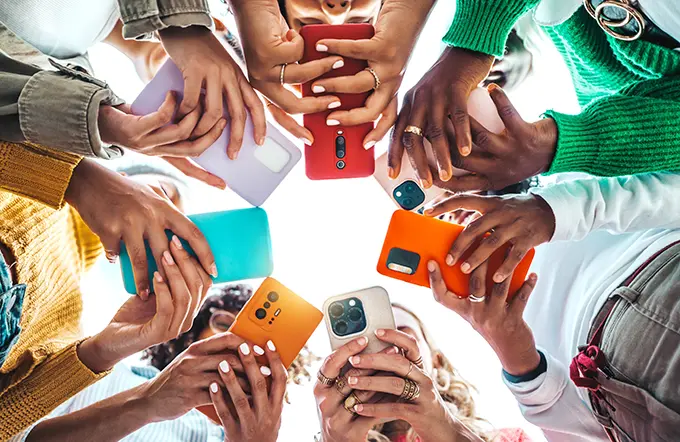When businesses make phone calls, it is very important to avoid being labeled as spam. Spam labels can make it difficult for people to trust a call and can stop them from answering. Legitimate communication helps businesses connect with their customers and partners in a meaningful way.
If calls are marked as spam, there are many risks involved. For example, important messages might be missed, and businesses could lose valuable customers. It can also damage the reputation of the company, making it difficult for businesses to call new prospects or reach out to current customers. Therefore, it is crucial for businesses to find ways to keep their calls clear and trustworthy. This way, they can improve their chances of having successful conversations.

Call Labeling Overview and Understanding Caller ID Technology
Call labeling helps people know if a call might be spam. When someone calls, their number shows up on our phones with a label like “Spam Likely” or “Spam Risk.” This system works by using caller ID technology to analyze the number and decide if it should be marked as spam. It helps us avoid unwanted calls and keeps our phones safer.
Telecom carriers play an important role in spam labeling. They collect data from calls and use it to help identify which numbers are suspicious. When a call comes in, the carrier checks its database to see if the number has been reported as spam. If it has, they label the call and send it to our phones, so we can decide whether to answer or not.
Third-party companies also help with call analytics. Companies like Hiya, First Orion, and TNS work with telecom carriers to provide extra information about callers. They use special algorithms and analytics engines to determine if a number is likely spam. This teamwork between carriers and third-party companies makes call labeling more effective and helps protect us from annoying telemarketers and scam calls.
Common Reasons for Spam and Scam Labeling:
- High frequency of calls from the same number in a short period.
- Use of numbers with incomplete or mismatched caller ID information.
- Calls failing to comply with legal and industry standards.
- Misleading information or targeting individuals on ‘Do Not Call’ lists.
- Consumer complaints and negative feedback.
- Unusually high call volume (more than 200,000 calls annually).
- Suspicious call patterns and history.
- Number spoofing.
- High call volume during after-hours.
- New numbers with high call volume.
- Repeated calls to the same number.

Complying with Regulations
To follow the rules, it is important to understand Do Not Call (DNC) lists and follow the Telephone Consumer Protection Act (TCPA) guidelines. These lists help protect people from receiving unwanted calls. By knowing who is on the DNC list, companies can avoid calling those numbers. Also, the TCPA sets specific rules about how and when businesses can contact people. When everyone complies with these regulations, it ensures that communication is respectful and that people’s choices are honored.

Strategies to Reduce Invalid Call Labeling
To reduce invalid call labeling, businesses can start by implementing STIR and SHAKEN protocols. STIR and SHAKEN protocols are innovative frameworks designed to tackle the issue of fraudulent call spoofing. At their core, these protocols aim to authenticate the identity of the caller before the call reaches the recipient.
STIR, short for Secure Telephony Identity Revisited, works by digitally verifying the caller’s identity, while SHAKEN, which stands for Signature-based Handling of Asserted Information Using toKENs, focuses on the practical application of this verification. Telecom providers use these frameworks to assign a trust token to calls, indicating their legitimacy.
This automated process helps reduce the instances of malicious spoofed calls reaching consumers, enhancing trust in telecommunications by ensuring that the information displayed on Caller ID is accurate and reliable. By adopting STIR/SHAKEN, businesses can reassure their customers that their communications are legitimate and reduce the chance of their calls being incorrectly labeled as spam.
How to Use Stir and Shaken Protocols
These protocols help verify that calls are coming from the numbers they claim to be. By authenticating calls, companies can protect their reputation and ensure that customers receive legitimate communications. This is important because many people ignore calls from numbers they don’t recognize, leading to missed opportunities.
Other Strategies for Improving Spam
Another strategy is to use omnichannel outreach. This means that businesses should not rely on just one method of communication, like phone calls. Instead, they can use emails, text messages, and social media to connect with their customers.
By spreading their outreach across different channels, companies can keep their communication balanced and maintain strong relationships with their audience. It also helps to ensure that customers know what to expect and when to expect it.
Additionally, businesses should register their numbers with the Free Caller Registry and work to maintain a positive number reputation. They can do this by ensuring that their calls are wanted and expected by the recipients.
This includes adopting consistent and reasonable call patterns, which makes it less likely for their calls to be marked as spam. Finally, registering for Caller ID and CNAM can help customers recognize who is calling, making them more likely to pick up the phone. These can typically be registered via your provider.

Building Trust with Recipients
Building trust with recipients is important for effective communication. One way to do this is by ensuring your name appears consistently on Caller ID. When people see a familiar name, they are more likely to pick up the call.
Additionally, using credible business phone numbers helps create a sense of reliability. If recipients can recognize your number as trustworthy, they will feel more comfortable answering your calls. A positive reputation is built over time, especially through regular, friendly contact that shows you care about your relationship with them.
It’s also essential to consider behavioral factors that can affect trust. Making excessive calls can damage your reputation, as people may see you as intrusive or annoying. To avoid this, you should practice ethical dialing methods. This means respecting recipients’ time and privacy, and only reaching out when it’s necessary. By focusing on building trust and following ethical practices, you can create stronger connections with your contacts and improve the effectiveness of your communication.
Additional Resources and Information
The Free Caller Registry is really important for keeping our phone calls safe. It helps people avoid unwanted calls and gives them more control. Companies should closely monitor their calls and listen to customer feedback to make improvements. If there are issues with how calls are labeled, using analytics engines can help find and fix these problems. It’s also a good idea to reach out for support from the FCC or local government to ensure everything is running smoothly.
Regular monitoring and verification are key to making sure calls are compliant. Companies can set up feedback mechanisms to track flagged calls, allowing them to catch issues early. They should also conduct regular audits of their call practices. Additionally, leveraging technology can make a big difference. By using analytics to recognize call patterns, companies can learn what works and what doesn’t. Implementing AI-based solutions can further support compliance efforts, making phone calls safer for everyone.
Conclusion
In conclusion, it’s important to remember the key practices we’ve discussed and how crucial it is to stick to them. By following these best practices, you can build trust and strengthen your relationship with consumers.
Always keep the lines of communication open and honest. This encourages customers to share their thoughts and feelings, making them feel valued and understood. When you prioritize clear communication, you create a positive experience that benefits everyone involved.
